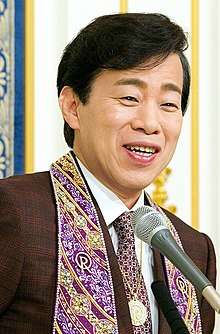Happy Science
Happy Science (幸福の科学, Kōfuku-no-Kagaku), formerly known as The Institute for Research in Human Happiness, is a controversial new religious and spiritual movement, founded in Japan on 6 October 1986 by Ryuho Okawa, which has been characterized as a cult.[3][4][5]
 Happy Science logo | |
| Formation | 1986 |
|---|---|
| Founders | Ryuho Okawa |
| Type | Japanese new religious movement |
| Headquarters | 1-2-38 Higashi Gotanda, Shinagawa-ku, Tokyo 141-0022, Japan |
Membership | 11 million (self-claimed),[1] 30,000 (estimated)[2] |
Master | Ryuho Okawa |
| Website | happy-science |
Formerly called | The Institute for Research in Human Happiness |

The Happy Science group includes a publication division called IRH Press, educational establishments such as Happy Science Academy and Happy Science University, a political party called the Happiness Realization Party, and three media entertainment divisions, which are called New Star Production, ARI Production and HS Pictures Studio.
History
Happy Science was founded on 6 October 1986 and was certified in Japan as a religious organization on 7 March 1991. According to Ryuho Okawa, its aim is "to bring happiness to humanity by spreading the Truth". Before its foundation, Ryuho Okawa published various books of "spiritual messages" that claim to channel the words spoken by religious and historical figures such as Jesus Christ, Confucius and Nichiren. In 1987, The Laws of the Sun, The Golden Laws, and The Laws of Eternity were published, forming the core textbooks of Happy Science, along with the fundamental sutra The Dharma of the Right Mind. In 1986, he resigned from a position at a trading corporation to found his own religion.[6]
Teachings

The basic teachings of Happy Science are "Exploration of the Right Mind" and "The Fourfold Path" and El Cantare belief. According to Okawa, in order to obtain happiness one must practice the Principles of Happiness known as "The Fourfold Path", Love that gives, Wisdom, Self-Reflection and Progress. The only requirement to join Happy Science is that applicants must have "the aspiration and discipline to seek the truth and actively contribute to the realization of love, peace and happiness on earth".[7] Among other teachings, they believe in reincarnation, demons, and aliens.[2]
At the same time, the organization's political wing, the Happiness Realization Party, promotes political views that include support for Japanese military expansion, support for the use of nuclear deterrence,[8] and denial of historical events such as the Nanjing Massacre in China and the comfort women issue in South Korea—see the Japanese-language version of the organization's online news bulletin, The Liberty.[9] Some other views include infrastructure spending, natural disaster prevention, urban development, and dam construction.[10] They also advocate fiscal conservatism, strengthening the US-Japan alliance, and a virtue-based leadership.[11] As of the spring of 2018, the Happiness Realization Party has 21 local councilors.[12]
Object of worship
Happy Science worships a deity named El Cantare who they believe is the "Highest God of Earth, the Lord of all gods". They believe that the being was first born on Earth 330 million years ago and that it is the same entity that has been worshipped at different times as Elohim, Odin, Thoth, Ophealis (Osiris) Hermes and Shakyamuni Buddha, with Okawa himself as the current incarnation.[2][13]
Facilities
General headquarters, worship facilities, and missionary sites are located in Japan and other countries. Worship facilities are called Shoja (精舎 or vihara in Sanskrit) or Shoshinkan (正心館). On 1 January 1994, as the first overseas branch, "Happiness Science USA" was established in New York.[14][15] The organization has branches in several countries including South Korea, Brazil, Uganda, the UK, Australia and India.[16]
Controversy
Happy Science is one of many Japanese new religions (shinshūkyō), which are looked upon as "controversial" by the mainstream press and public.[17] According to The Japan Times, "for many, the Happies smell suspiciously like a cult".[13][18] Not only the domestic Japanese press, but also international media in the United States, Uganda, Indonesia, and Australia have applied the term "cult" to Happy Science.[3][4][5]
Happy Science has released promotional videos that claim North Korea and the People's Republic of China are plotting to invade and colonize Japan after first subduing it through nuclear warfare.[18]
In February 2017, actress Fumika Shimizu abruptly retired from her former entertainment production agency while in the middle of multiple filming projects in order to pursue a full-time role in Happy Science, declaring she had been a member of the group since childhood under the influence of her parents, both of whom have been devout believers in Happy Science for a long time.[1]
Okawa's son, Hiroshi Okawa, has left the religion and is now an outspoken critic of the movement. In an article in The New York Times he commented "I believe what my father does is complete nonsense".[2]
The group sold "spiritual vaccines" claimed to prevent and cure COVID-19, advertised virus-related blessings at rates from 100 to over US$400, and sold coronavirus-themed DVDs and CDs of Ryuho Okawa lecturing, which are claimed to boost immunity, as of April 2020. After initially defying physical distancing measures, it later closed its New York temple, and administered spiritual vaccines remotely.[19]
References
- "Fumika Shimizu Retires From Acting to Join Happy Science Religious Organization". Anime News Network. February 2017. Retrieved 13 March 2019.
- Kestenbaum, Sam (16 April 2020). "Inside the Fringe Japanese Religion That Claims It Can Cure Covid-19". The New York Times. Retrieved 18 April 2020.
- Musasizi, Simon (21 June 2012). "Clerics call for probe into Happy Science". The Observer. Archived from the original on 22 December 2015.
- "Happy Science, a new cult offers celebrity guide to heaven". The Jakarta Post. 22 July 2012. Archived from the original on 25 August 2012.
- Donnelly, Beau (2 November 2015). "Blooming 'Happy Science' religion channels Disney, Gandhi, Jesus and Thatcher". The Age.
- Shimazono, Susumu (2004). From Salvation to Spirituality: Popular Religious Movements in Modern Japan (English ed.). Melbourne, Vic.: Trans Pacific. p. 267. ISBN 1876843128.
- "Happy Science - About Us". Happy Science Singapore. Archived from the original on 4 March 2016. Retrieved 13 December 2015.
- "The Happiness Realization Party". En.hr-party.jp. 21 September 2012. Archived from the original on 13 April 2018. Retrieved 24 October 2018.
- "The Liberty Web" (in Japanese). Retrieved 13 December 2015.
- "Happiness Realization Party". Happiness Realization Party. Archived from the original on 3 April 2016. Retrieved 31 March 2016.
- "Happiness Realization Party". Happiness Realization Party. Archived from the original on 12 June 2016. Retrieved 31 March 2016.
- About Japanese 50 new region (Japanese ed.). Takarajima. 19 April 2017. ISBN 978-4800270443.
- Saint-Guily, Sylla (3 October 2012). "Happy Science Is the Laziest Cult Ever". Vice. Archived from the original on 27 November 2015.
- 『「幸福の科学」教団史2008 法輪、転ずべし』p57
- 「月刊 幸福の科学」1994年2月号p50
- Muhumuza, Rodney (10 July 2012). "Happy Science, Controversial Religion From Japan, Succeeds in Uganda". The Huffington Post. Associated Press. Archived from the original on 12 July 2012.
- McNeill, David (4 August 2009), "Party offers a third way: happiness", The Japan Times, retrieved 6 August 2009
- Kestenbaum, Sam (16 April 2020). "Inside the Fringe Japanese Religion That Claims It Can Cure Covid-19". The New York Times.
Further reading
- Astley, Trevor (1995). "The Transformation of a Recent Japanese New Religion: Okawa Ryuho and Kofuku no Kagaku", Japanese Journal of Religious Studies 22 (3-4), 343–380
- Baffelli, E; Reader, Ian (2011). Competing for the apocalypse: religious rivalry and millennial transformations in a Japanese new religion. International Journal for the Study of New Religions 2 (1), 5-28
- Clarke, Peter B. (ed.) (1999), 'Kofuku-no-Kagaku: The Institute for Research in Human Happiness' in A Bibliography of Japanese New Religious Movements: With Annotations, Surrey, UK, Japan Library (Curzon), ISBN 1-873410-80-8, pp. 149–67
- Pokorny, Lukas; Winter, Franz (2012). Creating Utopia': The History of Kofuku no Kagaku in Austria, 1989–2012, with an Introduction to Its General History and Doctrine. In: Hödl, Hans Gerald and Lukas Pokorny, ed. Studies on Religion in Austria. Volume 1, Vienna: Praesens, pp. 31–79
- Yamashita, Akiko (1998), 'The "Eschatology" of Japanese new and new new religions: from Tenrikyo to Kofuku-no-Kagaku', Japanese Religions 23, 125–42